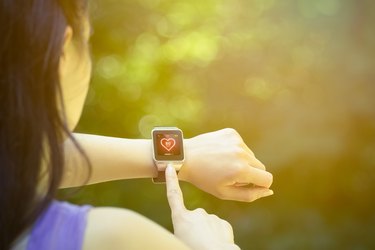
Blood pressure is typically measured when the body is at rest, so it can be surprising to learn how much this common vital sign changes with physical activity. In fact, exercise causes an immediate increase in blood pressure -- particularly in the systolic, or top blood pressure number. How much your blood pressure changes during exercise correlates with your fitness level and health status, as well as the type and intensity of exercise, and these changes may provide important clues to your health.
About Blood Pressure
Video of the Day
Blood pressure measurements consist of two numbers. The first figure, the systolic, represents the pressure when your heart is contracting, and the second, or diastolic number, is a measure of the pressure in between beats -- when the heart is relaxed. Ideal resting blood pressure levels are below 120 systolic, and below 80 diastolic, or less than 120/80 mm Hg. According to the American Heart Association, the earliest stage of hypertension, or high blood pressure, is diagnosed when readings increase to 130/80 or above. Blood pressure is greatly influenced by cardiac output, or how much blood your heart pumps per minute, and peripheral resistance, which is the resistance of arteries to blood flow. These factors help to explain why blood pressure varies person to person, and why it changes with exercise.
Video of the Day
Blood Pressure During Exercise
How much your blood pressure increases with exercise depends on your usual resting blood pressure levels, and your work rate, or the type, intensity and duration of physical activity. During exercise, your heart rate -- and systolic pressure -- go up, because cardiac output increases to pump more blood and oxygen to working muscles. In people without hypertension, most types of exercise can push systolic blood pressure to the 160 to 200 mm Hg range, and intense exercise such as weight lifting can temporarily push systolic pressure to even higher levels. Exercise also causes vasodilation, or the widening of blood vessels, which increases blood flow and decreases peripheral resistance -- which, in healthy people, keeps the diastolic blood pressure from rising during activity.
Exaggerated Blood Pressure Response
In people with hypertension, a greater than expected increase in systolic and diastolic pressure can occur with exercise. Specifically, systolic pressure levels above 190 in women and above 210 in men are considered exercise hypertension and should be evaluated, as this exaggerated blood pressure response is commonly a result of artery stiffness and increased peripheral resistance -- and associated with a future risk of hypertension and heart disease. In people with coronary heart disease, abnormally low systolic and diastolic blood pressure may occur during exercise, and this also requires prompt evaluation. Anyone with hypertension or heart disease should seek and follow their doctor's advice in order to safely incorporate exercise into their lifestyle.
Blood Pressure After Exercise
Right after exercise is stopped, blood pressure decreases -- often to levels a bit lower than normal resting blood pressure, and this effect can last for hours. Also, people who exercise regularly usually experience permanent improvements in resting blood pressure levels, as exercise strengthens the heart, helps with weight loss, improves circulation and lessens peripheral resistance -- all factors that benefit blood pressure.
Warnings
An increase in blood pressure during exercise, particularly the systolic reading, is normal and expected, with levels that return to the usual resting range after recovery from exercise. However, some people experience abnormally low or high blood pressure during exercise, and this requires medical assessment. If you have hypertension that is not controlled, do not start an exercise program until your doctor approves that exercise is safe for you. If exercise causes severe shortness of breath, weakness, or dizziness, or causes any chest pain, even if this pain goes away when you stop, let your doctor know right away. Stop exercising and seek immediate medical attention or if you have chest pain, severe shortness of breath or pain in other areas, such as your arm, jaw or neck.
Reviewed by Kay Peck, MPH RD
- Circulation: Relations of Exercise Blood Pressure Response to Cardiovascular Risk Factors and Vascular Function in the Framingham Heart Study
- BioMed Research International: Blood Pressure Response to Submaximal Exercise Test in Adults
- Cor et Vasa: The Determinants of Blood Pressure Response to Exercise
- Centers for Disease Control and Prevention: Physical Activity and Health: A Report of the Surgeon General
- The Journal of Clinical Hypertension: Exaggerated Systolic Blood Pressure Response To Exercise
- Hemodynamics of Hypertension: Clinical Significance of Blood Pressure Levels During Treadmill Exercise Testing
- American Heart Association: What Is High Blood Pressure?
- American Heart Association: Understanding Blood Pressure Readings
Is this an emergency? If you are experiencing serious medical symptoms, please see the National Library of Medicine’s list of signs you need emergency medical attention or call 911.